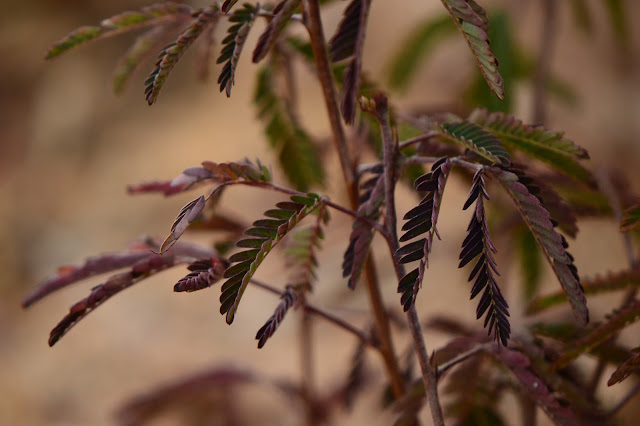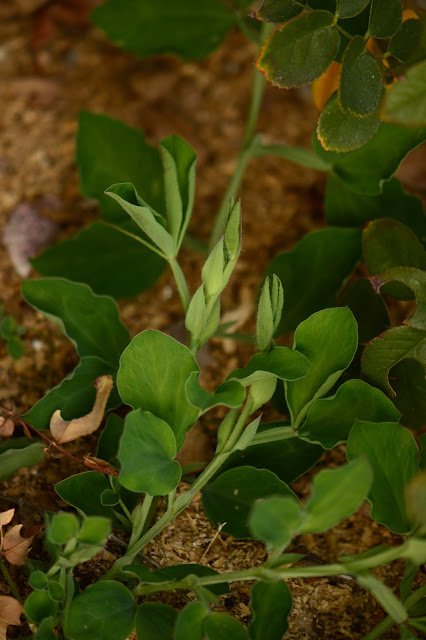First of all, many thanks to those of you who gave me the name of this feature: nyctinasty. Varied hunts across Google tell me that the term applies to both leaves and flowers. Botonists remain uncertain of the advantages of this activity. In the case of leaves, the action occurs particularly in the Legume family, of which the Palo Verde (Parkinsonia florida) is a member, along with a number of other useful desert species.
 |
| Parkinsonia florida exhibiting nyctinasty, the folding of leaves for the night |
But it also occurs in species from more temperate zones. One article referred to such common plants as French beans (Phaseolus vulgaris) and clover (Trifolium repens). So I began to wonder, what else am I missing?
At present I am growing one legume more normally associated with cooler climes, namely, sweet peas. Here are the leaves in afternoon shade.
I am not sure whether this is nyctinasty or not. Certainly the lower leaves are still wide open, so the upper may be merely new growth? Looking at the pictures, I suspect so although my impression was otherwise out in the garden.
Any opinions and other observations welcome! I will have to go out in the morning and double check what the upper leaves are doing then.
That is about the best I can do at the moment!
Elsewhere in the garden...
Yesterday I made a trip to Elgin's Nursery - a real 50 minute one way trip to a real nursery. And most of the plants I came home with are worth looking at for their foliage alone.
Aloe "Blue Elf"...
...the young tree (or large shrub) Vauquelinia californica, known as Arizona Rosewood...
...and especially Opuntia "Gumbi" - not something on my to-buy list, but I simply couldn't pass it up! So far as I have noticed, this is an Opuntia with few spines and few or no glochids, and look at those wonderful colours! I dug a hole for it this morning, meaning to get it in the ground immediately, then remembered that I have been advised to give cactus species a week's drying out before planting. Gumbi is now sitting in his hole - still in his pot, waiting.
In addition to yesterday's purchase, there is another small aloe in the garden now. This is the very small "Crosby's Prolific". Sure enough, I can already count three pups on this tiny plant, which can't be more than six inches high at present, if that.
And a final set of leaves that I am intrigued by at the moment: Cerinthe major "Purpurea", which I managed to grow from seed (never my strong point) and am wishing well and floriferous. I've never seen these before, let alone seen them in bloom, but I've loved the pictures for years. High time I tried growing them! The foliage feels rather succulent and is a lovely greeny-grey colour in full daylight.
Nyctinasty and assorted succulents for this month's Garden Bloggers' Bloom Day! To see what foliage others have been looking at this January, check out Christina's My Hesperides Garden...
Weather Diary: Partly cloudy; High: 72 F (22 C)/Low: 41 F (5 C)









What a fascinating post; thank you for writing about something I wasn't really aware of. Certainly I do know that lots of flowers close at night and that makes sense from the point of view of not wasting pollen to the 'wrong' insect ect. but there doesn't seem a very obvious advantage to leaves. This is a great post for GBFD, thanks so much for joining this month.
ReplyDeleteIt's one of those things that makes one wake up and realize how much may be going on in the garden without being noticed. Perhaps someday we'll find out the reason why some leaves fold at night; at first, inevitably, I had one or two good theories - until I learned the phenomenon is not limited to warm climate plants... I shall leave it to the botanists for now, I think! Thanks so much, Christina!
DeleteI think you will love Cerinthe major 'Purpurea' which I grew from seed last year in my cut flower bed and it worked so well in many arrangements. I remember now that sweet peas also close their leaves in the shade - a continuing and fascinating subject!
ReplyDeleteAnd I missed checking the sweet peas this morning; I was out busily planting and forgot to look...! I'm glad to get your experience on the sweet peas as I couldn't quite make up my mind; but it did look like the same thing I saw in the other plants. I'm sure your use of the Cerinthe helped tip the balances on my trying them; I'm willing it to grow on to blooming stage quickly now...
DeleteYour succulent collection is expanding! Watch out - the plants become addictive!
ReplyDeleteThe addiction is coming along nicely, isn't it? It's taking me some time to learn which succulents work here and which don't... In fact, I just transplanted the second Aloe as it showed signs of stress from too much sun. Apparently even most aloes prefer filtered shade in the low desert!
DeleteMy Oxalis plants close their leaves as afternoon fades. And our Namaqua daisies only open their flowers between 10 and 4, such a civilised life!
ReplyDeleteCerinthe is a gorgeous plant, both the leaves, and the flowers
Very civilised ;-) I have trouble with too many flowers that close in full daylight; since my garden slopes east, I'm apt to just see the closed flowers during summer's longer days... I'm so looking forward to seeing the Cerinthe in bloom. By the way, I thoroughly enjoyed your post on watching the lions.
DeleteI love all your succulents Amy! Gumbi is really striking. Its funny how you brought up about the folded leaves on sweet peas because I was looking at the seedlings I have coming along last week and was remarking on how their new leaves were folded too and thinking back to your last blog post. Its a very interesting phenomena.
ReplyDelete- Kate
I found Gumbi on offer again a few days ago - at Lowe's... Just the thing for my yellow and orange themed East Border though! I'm still debating about the sweet peas, as the new foliage certainly curls a good deal anyway - I'd be curious to know what you find with yours through the season. Glad you have some started too; mine are certainly taking their time, but I just learned that we're expecting another bout of colder weather next week so perhaps they're wiser than I...
Delete